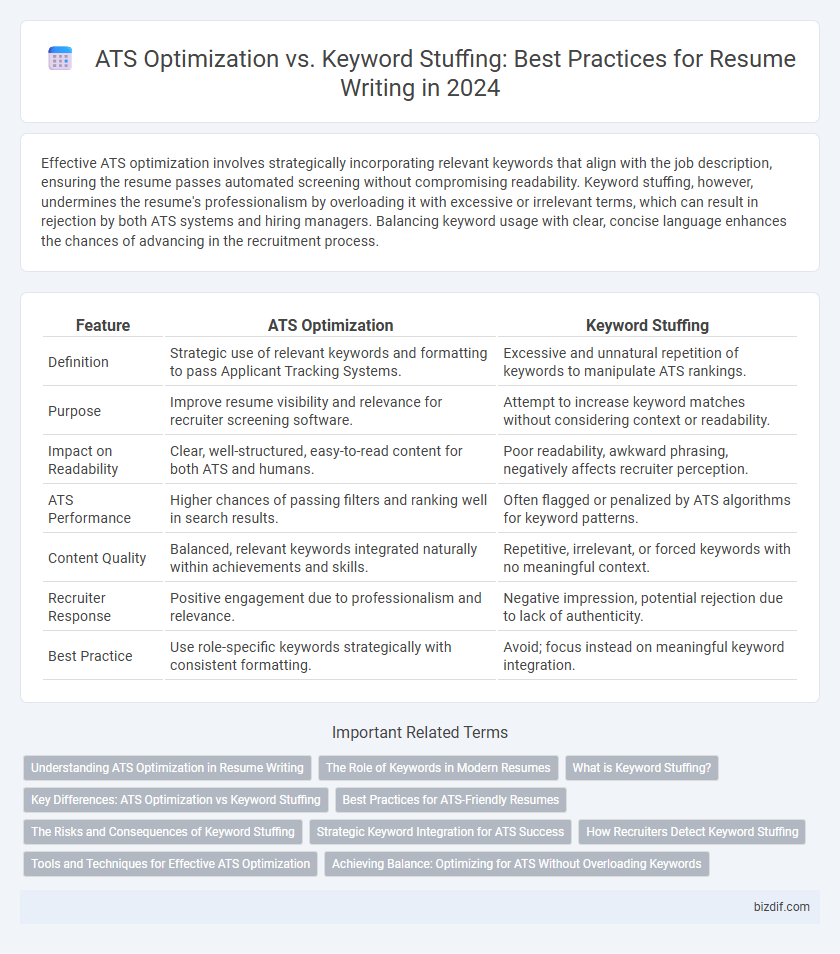Effective ATS optimization involves strategically incorporating relevant keywords that align with the job description, ensuring the resume passes automated screening without compromising readability. Keyword stuffing, however, undermines the resume's professionalism by overloading it with excessive or irrelevant terms, which can result in rejection by both ATS systems and hiring managers. Balancing keyword usage with clear, concise language enhances the chances of advancing in the recruitment process.
Table of Comparison
| Feature | ATS Optimization | Keyword Stuffing |
|---|---|---|
| Definition | Strategic use of relevant keywords and formatting to pass Applicant Tracking Systems. | Excessive and unnatural repetition of keywords to manipulate ATS rankings. |
| Purpose | Improve resume visibility and relevance for recruiter screening software. | Attempt to increase keyword matches without considering context or readability. |
| Impact on Readability | Clear, well-structured, easy-to-read content for both ATS and humans. | Poor readability, awkward phrasing, negatively affects recruiter perception. |
| ATS Performance | Higher chances of passing filters and ranking well in search results. | Often flagged or penalized by ATS algorithms for keyword patterns. |
| Content Quality | Balanced, relevant keywords integrated naturally within achievements and skills. | Repetitive, irrelevant, or forced keywords with no meaningful context. |
| Recruiter Response | Positive engagement due to professionalism and relevance. | Negative impression, potential rejection due to lack of authenticity. |
| Best Practice | Use role-specific keywords strategically with consistent formatting. | Avoid; focus instead on meaningful keyword integration. |
Understanding ATS Optimization in Resume Writing
ATS optimization in resume writing involves strategically incorporating relevant keywords and phrases that match the job description to ensure the resume passes automated screening systems. Effective ATS optimization balances keyword relevance and natural language, avoiding excessive repetition or keyword stuffing that can lead to rejection. Understanding ATS algorithms and tailoring your resume content accordingly increases the chances of your application reaching human recruiters.
The Role of Keywords in Modern Resumes
Effective ATS optimization integrates relevant keywords naturally to improve resume visibility while avoiding keyword stuffing, which can lead to penalties or rejection. Modern resumes use strategic keyword placement aligned with job descriptions to ensure compatibility with applicant tracking systems without compromising readability. Keywords related to industry-specific skills, certifications, and action verbs enhance both ATS performance and recruiter engagement.
What is Keyword Stuffing?
Keyword stuffing refers to the excessive and unnatural repetition of specific keywords in a resume to manipulate Applicant Tracking Systems (ATS). This practice can result in poor readability and may lead to automated rejection, as ATS algorithms are designed to detect and penalize keyword abuse. Effective ATS optimization balances relevant keywords with clear, concise content that aligns with job descriptions without overloading the text.
Key Differences: ATS Optimization vs Keyword Stuffing
ATS optimization focuses on strategically incorporating relevant keywords and phrases that align with job descriptions to ensure a resume is parsed accurately by Applicant Tracking Systems. Keyword stuffing involves overloading a resume with excessive or irrelevant keywords, which can result in a negative impression and potentially lead to rejection by ATS algorithms. Effective ATS-optimized resumes balance keyword use with clear, concise content that highlights skills and qualifications without compromising readability.
Best Practices for ATS-Friendly Resumes
ATS optimization involves strategically incorporating relevant keywords naturally throughout the resume to ensure compatibility with applicant tracking systems without compromising readability. Keyword stuffing, by contrast, entails overloading the resume with excessive keywords, which can trigger ATS filters and damage the candidate's credibility. Best practices for ATS-friendly resumes emphasize balanced keyword integration, clear formatting, and the use of standard headings to enhance resume parsing and improve visibility in automated screenings.
The Risks and Consequences of Keyword Stuffing
Keyword stuffing in resume writing leads to ATS rejection due to unnatural language and keyword overuse, making content difficult to read. Overloaded resumes can trigger automated filters, resulting in missed job opportunities and reduced recruiter engagement. Employing strategic ATS optimization ensures keyword relevance while maintaining readability to increase interview chances.
Strategic Keyword Integration for ATS Success
Strategic keyword integration enhances ATS success by incorporating relevant industry-specific terms naturally within the resume content, improving scanability without triggering keyword stuffing penalties. Effective ATS optimization balances keyword density with contextual relevance, ensuring that applicant tracking systems accurately identify skills and qualifications aligned with the job description. Prioritizing quality over quantity in keyword usage maximizes resume visibility while maintaining readability for human recruiters.
How Recruiters Detect Keyword Stuffing
Recruiters detect keyword stuffing by using advanced ATS algorithms that analyze the natural flow and contextual relevance of keywords within a resume. Excessive repetition or unnatural placement of terms triggers red flags, signaling a lack of genuine experience or skills. Effective ATS optimization balances keyword inclusion with coherent language aligned to the job description, improving both human and machine readability.
Tools and Techniques for Effective ATS Optimization
Effective ATS optimization relies on smart use of ATS-friendly tools such as Jobscan, ResyMatch, and SkillSyncer to analyze job descriptions and tailor resumes with relevant keywords. Techniques like integrating keywords naturally within achievements and using standard headings improve resume parsing accuracy and prevent keyword stuffing, which can trigger ATS rejection. Leveraging resume templates designed for ATS compatibility combined with targeted keyword placement enhances the chances of passing automated screening and reaching human recruiters.
Achieving Balance: Optimizing for ATS Without Overloading Keywords
Achieving balance in resume writing involves strategically integrating ATS-friendly keywords without resorting to keyword stuffing, which can undermine readability and reduce engagement. Using relevant, contextually appropriate terms aligned with job descriptions enhances ATS parsing accuracy while maintaining a natural flow that appeals to human recruiters. Prioritize quality over quantity by embedding keywords in accomplishment-driven statements to optimize both ATS ranking and overall resume effectiveness.
ATS Optimization vs Keyword Stuffing Infographic

 bizdif.com
bizdif.com